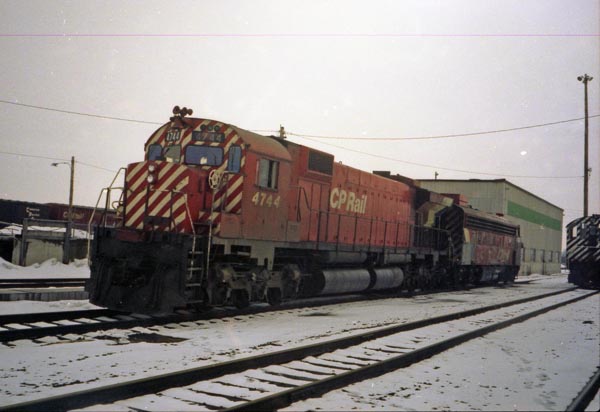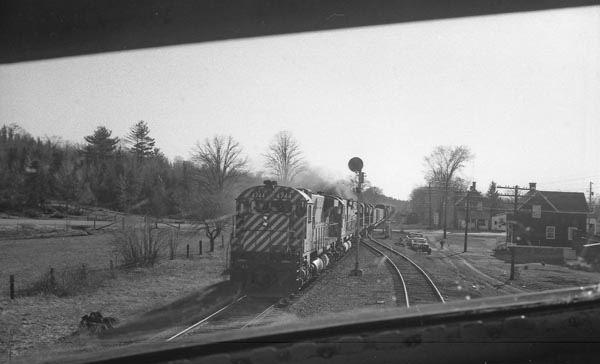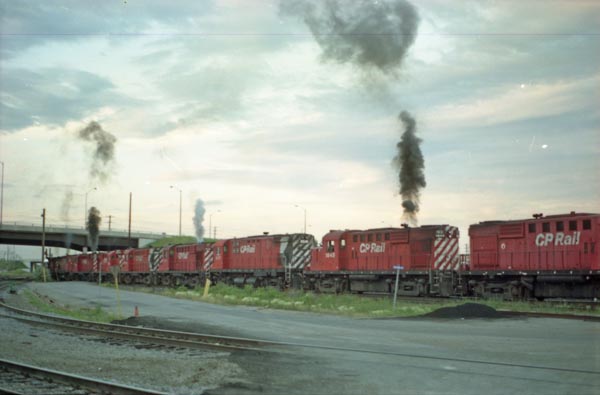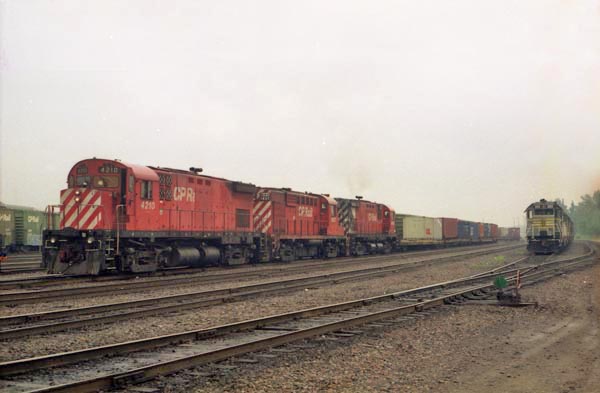
|
J.I.C.
Ken Jones, the crackerjack electrician (see April 2007 Branchline), worked in the Operations Centre in CPR's Montreal Windsor Station on the mechanical desk for several years before he retired in the 1 980s. Each shift had one mechanical officer, and three transportation supervisors (I was one of the three). The three transportation guys covered: 1) the East Desk which looked after the Dominion Atlantic Railway through to Windsor and Cartier, Ontario; 2) the Prairie Desk which looked after Cartier through to Swift Current, Saskatchewan, and Hardisty, Alberta; and 3) the West Desk which handled west to the Esquimalt & Nanaimo on Vancouver Island. The mechanical officer covered the whole system. The mechanical desk fellows used to file a '5 am Report' that went to every Tom, Dick and Harry in the CPR's higher echelon denoting unit failures, where and the reason.  4744 before its first run at Toronto on 29 March 1970. At the time in question, one-of-a-kind M-640 4744 was flopping quite a bit out on the road. One 12 midnight to 8 AM shift, the 4744 was on Train 916 from Windsor to Montreal, and the train was out of London heading for Toronto and all was well. We then got a call from the night shop foreman at London asking us to let Toronto know that 4744 would need water when it arrived in Toronto. The transportation guy on the East Desk, who was a jokester, put a paper tag on the magnetic tag for 4744 (every unit had a magnetic tag for positioning on a 'status' board) with a red button (denoting that the unit was either idle or dead) above it, and on the paper tag was written 'J.I.C.'.  4744 at Walkley Shop having just brought in train 85 from Montreal on 24 March 1974. Ken Jones was 'walking the board' covering the entire CP system looking for dead or isolated units that he would put on his 5 am report, and there was 4744 on Train 916 between London and Toronto with its red button and the tag 'J.I.C.'. So on his 5 am report he listed all the units that were defective on the system, and in the middle of the report was '4744 dead, train 916 to Toronto, reason JIC'. We all went home at 8 am, just as the s@#$ was hitting the fan all across the mechanical department of the CPR. Ken Jones was awakened from a deep sleep by an irritated Chief of Motive Power and Rolling Stock, asking what 'J.I.C.' meant ... and Ken didn't know.  4744 on train 952 at Castleford in the Ottawa Valley on 5 October 1972, taken from the cab of 1402 on train 1, "The Canadian". When the unit arrived in Toronto a short while later, it was running but was almost out of water to which the Toronto shop attended. That night when the jokester transportation guy arrived at work, he was 'accosted' by Ken Jones asking what J.I.C. meant. "You should know, it means 'Just In Case'. If that unit had run out of water between London and Toronto, it would have been dead, which it usually was anyway!" Ken was always running up to the magnetic board from his seat on the mechanical desk, situated behind the transportation desks. We transportation guys had a bad habit of leaving the drawers on our desk open (they contained timetables, tonnage ratings, etc.). When Ken would get a call about a locomotive in trouble, he'd rush to the magnetic board to make sure of the train number, and also to make sure the locomotive number was correct .... often without looking where he was going. He'd invariably bash his shins into those open drawers, and a loud crash and curse would soon follow. How he never lost his balance and went through the window and landed on Peel Street four storeys below always amazed me. The good 'ole daze. Automatic Equipment Identification Malfunction One of the problems for Canadian Pacific's Eastern Lines is the first week (end) in July. In Canada, CP continues to run trains on Canada Day, July 1. However, in the United States most trains do not operate on their July 4 holiday. I was working at St. Lawrence & Hudson's [CPR's Eastern Lines] Motive Power Bureau in Toronto Union Station on Sunday, July 6, 1997, and I could see trouble brewing in that lots and lots of power was stuck in the Detroit/Windsor area. Windsor had taken in trains 921 and 923 from Toronto and St. Luc; the Norfolk Southern and CSXT had run their 510 and 516 into Windsor. There was only to be one train run east out of Windsor due to the US holiday and the time it would take for the traffic to pick back up. And it was the same in Toronto - I had scads of power in Toronto but no way to get it to Montreal where there was about to be a power shortage. The only Toronto to Montreal train was slow 906. Time to run a light engine move from Toronto to Montreal. Toronto needed all the SD40s and SD40-2s that they could muster, but 4-axle MLW units were the usual power for 906. I had the shop build Train 906 with 1845, 1826, 1860, 1803, 1809, 1846, 4211 and 1813 (all RS-18u's except C-424 4211), and there were two more MLWs over at the 'van' track on the north-east side of the yard that I would add on, C-424s 4223 and 4231. But this was one of the notorious 'lieu' days at the shop, and there was no way for the shop guys to move the power from the van shop to the diesel shop. So when train 906 got ordered, he would be ordered 30 minutes ahead of his normal leaving time to go to the van shop to lift the 4223 and 4221. But how to get the seven extra MLW units out of Windsor (1815, 4238, 1822, 1835, 1812, 1824 and 4241)?. If I left them there for Train 926, then I'd have a shop full of SD40s and SD40-2s left over for Monday, July 7, and traffic was still programmed to be light. So I called the pope and all the cardinals and archbishops in Toronto's head office at the time, and got authority to run those seven units light from Windsor to Toronto. And Toronto was still bursting with power, so I suggested that the seven light units from Windsor go to the shop, lift the ten MLWs in Toronto, and run light to Montreal. Train 906 could get a bunch of SD40s which would help out Montreal on Tuesday, July 8. The seven units left Windsor at 1205. The Rail Traffic Controller figured that the light engine move would not go too fast, so he ordered him at London for about 1435. He pulled into Quebec Street in London at 1405, sat for 30 minutes, and left at 1435. I finished my shift at Toronto Union Station at 1800, and headed up to Agincourt (Toronto Yard), and got there just as the seven light engines arrived. They backed into the shop, coupled onto the eight units that had been for Train 906, and did a brake test. I was escorted up to the tower on the Havelock side of the yard office to watch as 15 smoky MLWs killed a lot of mosquitos in Toronto Agincourt as he opened up the throttle to go over to the van shop to lift the other two units. However, this crew was in no hurry to get to Smiths Falls and they diddled so long that it was dark when he finally pulled out with the 17 units - so much for decent photos. I went home to bed. I realized later that I should have awakened some of the Montreal railfan mafia, but was lax in my duties! Next day, I went into the office in Toronto Union Station on my days off to see how things progressed, and there were five trains ordered in St. Luc (Montreal) with 'my' 17 units.  Smoking up the mosquitoes at Toronto on 6 July, 1997. 15 units here are going over to the 'van shop' to pick up another two units. But that wasn't all that was there. This was on my computer screen from my boss: "Throughout the night, I had several calls from Winnipeg to advise me that AEI (Automatic Equipment Identification) was malfunctioning system-wide. Around 0310, I received another call from Winnipeg advising me that the Extra East handling 17 units to Montreal was causing the system to fail as AEI can only handle 10-unit consists. Shortly thereafter, I received a call from the Director in Calgary asking me to set the power off en route. I told him that the train had already left Smiths Falls and would be in Montreal around 0600. Not understanding the extent of the problem at the time, I felt that this would be adequate. The Director advised me that it was affecting all trains and all the AEI sites across the system. The AEI problems were not affecting our trains at the terminals to any degree. We checked to see how many more readers that the train would be passing and realized that before the train arrived in Ballantyne that it would only pass one more reader at Dorval. So we had Calgary arrange for this reader to be temporarily disconnected." So much for 17-unit moves!! End of the Line for MLW Units We had been using four four-axle MLW units on the Hochelaga Transfer from St. Luc (Montreal) during the early weeks of June 1998, namely 4210, 1837, 1838 and 4216. The 4230 had been in the shop for some minor work. When it came out, I arranged for #921-20 to have the last five operating MLWs through to Windsor on June 20, 1998. That afternoon (Friday, the 19th), we had received a note from the General Manager of the STLH that Western Lines was sending east 10 HLCX units, and upon their arrival, all the MLW's still running and serviceable were to be tied up, retired, and sold if possible. However, these 10 HLCX units were still out in God's country, so I had time to play! Train 921 left St. Luc early Saturday morning, arriving at Smiths Falls quite early. However, there was a track block on the Belleville Sub, so the train was held, and ordered to leave about 1000. The units were sitting on #1 long track, beside the westward main track, and as there are houses just across the street from this point, the units were shut down. When it came time to leave, the engineer would only get two or three units started, one or two would die, and this went on for a good half hour. A couple of railfans headed out to the Mud Lake trestle in the Canadian Shield west of town to wait for this guy, and wait they did. Finally, 4210, 1837, 1838, 4216 and 4230 got out of town in a blast of Alco/MLW smoke. When I photographed him west of Elmsley, approaching Perth, Ontario, the 4210, 1837 and 4230 were working, and 1838 and 4216 were still dead, unable to get started.  4210-1837-4230 at St. Luc Yard, Montreal on 4 July 1998. Upon arrival at Windsor, the two dead ducks came home dead on Train 926, and the other three worked on separate trains back to St. Luc. Units 4210, 1837 and 4230 were kept on the Hochelaga Transfer out of St. Luc until the General Manager put his foot down - "Remaining MLW's are to be shut down by 2359 tonight" - this was July 7, 1998. I believe that the Public Affairs Department was on hand for the final departure for pictures. But they didn't get any exposure after the embarrassing 'final' shutdown of the big MLWs (4500s and 4700s) eons ago, and their eventual return to service until they finally all gave up the ghost. The units got delayed arriving St. Luc, and somewhere in my collection is the communique from St. Luc: 4210-1837-4230 shut down at 0015, July 8, 1998. I was still employed the following day, so I guess the 15 minutes weren't too hard on the G.M. Bytown Railway Society, Branchline, May 2007, page 18. |
![]()